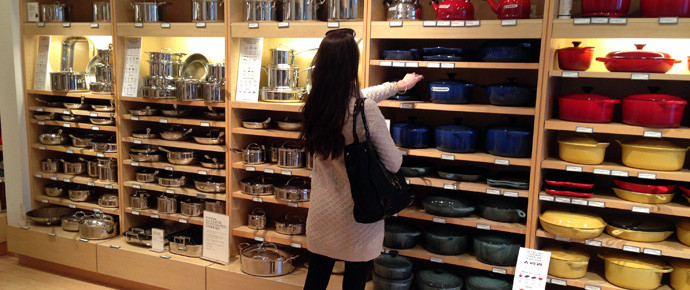
How to Attract the DIY Consumer Like Williams-Sonoma

Williams-Sonoma is one of those great American Dream stories: it started with one store in 1956 and has grown into one of the top US retailers with over 255 stores nationwide. This well established, well respected brand keeps consumers coming back, and keeps them paying top dollar for quality products.
Brands with staying power deserve a closer look at what they are doing right and how your company can make similar moves to attract consumers.
Williams-Sonoma has the “Pleasant Shopping Experience” Down to a Science
Almost every time you wander past a Williams-Sonoma, it seems to be filled with people wandering, touching, oohing and awing.
There is usually something bubbling on the stove, being stirred by a friendly, apron-clad salesperson. Shoppers are offered free samples and cooking tips while they wander the store. Shelves are neatly organized with wide aisles and in-store displays.
Being in a Williams-Sonoma feels more like visiting Martha Stewart’s house than browsing a retail store. Unlike most retail experiences, you leave feeling pampered, refreshed and ready to cook some Duck à l'orange.
All those warm and fuzzy feelings lead consumers to want to purchase from the store to bring those warm-fuzzies home with them. Even Pinterest is filled with pins on “How to make your house smell like Williams-Sonoma.”
Lesson: Set the stage
Williams-Sonoma sells cookware, kitchenware and high-end pantry items, so they have set up their retail stores to feel like a high-end kitchen.
Set the stage for your consumers so they feel like they are a part of your brand. Ongoing demonstrations of your products in the store are a great way to engage customers with your products before they buy. Offering tips and advice will also engage customers while making them feel valued and capable of taking on the task at hand.
Although you may not be able to install a working stove or other major appliance in your retail store, consider what you can do. If you sell paint supplies, invest in some drywall or canvas to demonstrate different painting techniques like using painter’s tape to create designs or how to clean up drips.
Create an environment where your products are being used organically, rather than just shelves stocked with items to purchase. Give your customers positive memories to tie to their purchase, so they will remember where they purchased it and will want to purchase from you again.
Williams-Sonoma Knows How to Fight "Showrooming"
Showrooming is the now common practice where consumers come to brick-and-mortar locations to touch and feel products, only to leave and purchase the product from a (probably cheaper) online retailer.
Showrooming has caused a major hit to store profits across most retail genres. Zach wrote a previous post about a few strategies to boost consumer’s likelihood of making a purchase from your physical store location.
No retailer is immune to showrooming, so Williams-Sonoma is combating it in two ways (and you can too):
1.They offer exclusive products that you can’t get anywhere else.
2.They plan to increase customer engagement in stores.
Williams-Sonoma’s CEO Janet Hayes says that one strategy for 2014 will be increased store tastings, cooking and product demonstrations to engage consumers — something that an online retailer can't provide.
Lesson: Fight back with a great customer experience
If possible, offer unique products or product-features that consumers can’t find anywhere else. Exclusive products not only bring in profit for those specific purchases, but also add to the overall perceived value of your brand.
Exclusive product lines are a huge plus for the DIY Consumer. DIY Consumers are more likely to purchase, and possibly pay more, for a product they feel is unique and high-value.
If you can’t offer one-of-a-kind products, you can increase customer engagement in other ways. As I stated above, in-store demonstrations will engage your customers in the moment and drive them to purchase on the spot. Positive, face-to-face interactions with your customers are a great way to offer them something they can’t find online.
Williams-Sonoma Isn’t Afraid to Expand
Williams-Sonoma acquired Pottery Barn in 1985 and launched its more modern housewares line, West Elm, in 2002. In fact, you can get a play-by-play of theWilliams-Sonoma timeline on their corporate website.
Williams-Sonoma is a successful business that has learned to expand and grow with changing times. It’s important to note here that both Pottery Barn and West Elm, while related, were outside the original idea behind Williams-Sonoma, kitchen products and cookware.
What I mean is, Williams-Sonoma didn’t just grow so big that it bought out the competition, instead it saw the opportunity to grow out of kitchenware and into housewares as well.
The launch of their latest brand, West Elm, shows that Williams-Sonoma isn’t afraid to expand beyond its classic feel in order to reach a new demographic. West Elm has a distinctly modern design feel that is very different from its parent brand. West Elm also emphasizes sustainably manufactured goods and supporting smaller artists through its partnership with etsy.com.
Lesson: Take a Step, Any Step
If you are a smaller company, you’re probably thinking that you’re brand couldn’t tackle opening another whole business just to appeal to more consumers. And while you’re right, you’re also wrong.
Williams-Sonoma is taking tons of little steps, not just big ones. They are increasing their reach by finding creative outlets for social media,incorporating smaller businesses and creators from Etsy.com and ramping up their online presence with a design blog and online reviews of products.
If you’re business isn’t ready to launch a whole new brand, here are some smaller-scale opportunities to help you increase your reach:
- Get creative with social media. Pinterest is a great way to engage consumers on the creative level.
- Don’t forget about print. Williams-Sonoma has a successful line of cookbooks that consumers love. Instead of offering customers how-to pamphlets from other professionals, why not create a how-to yourself?
- Promote small, local businesses – create a small space in your store to display and sell merchandise made by local artists. You could rent the space out, or charge a small percentage fee of all purchases to help turn a profit.
- Start a blog that pertains to your business to discuss trends, address concerns and reach customers who want to know more but don’t know where to start.
- Encourage customer reviews on your website. Email customers who have purchased in the past and ask for them to review the products on your site. Remember, 90% of consumers are influenced to purchase by positive online reviews
Williams-Sonoma has also had great success with their in-store cooking classes. Several other retailers like Michaels and Home Depot have found great success with workshops as well.
Workshops are a great way to engage with your customers and earn their loyalty, while helping them build skills that will require future purchases of your products.
Williams-Sonoma Understands eCommerce
Online sales represented 42% of their revenue in 2012 because Williams-Sonoma understands the importance of eCommerce. Williams-Sonoma.com is an extension of the customer engagement that consumers have come to expect from this high-end retailer.
Their websites are well organized, well maintained and have a great user interface. Their products are often tagged with enticing descriptions like “new” and “exclusive” to let the consumer know they won’t be able to find the products anywhere else.
They offer cooking tips and menu ideas, just like they do in stores. And they even have a blog called Taste Williams-Sonoma to further engage with customers.
They are working to make the shopping experience seamless across all channels – including mobile, online and in stores. So they are seen as a unified brand instead of separate entities.
They see us as a brand, and the experience should be seamless—customers have become less tolerant of anything less than perfection.
-Pat Connolly, Executive Vice President and CMO of Williams-Sonoma
Williams-Sonoma ranked first for online shopping experiences in 2012 according to The e-tailing Group.
They are also getting attention for their exceptional customer emails from groups like Retail Email. The Williams-Sonoma emails are created in a newsletter format, and offer the familiar tips and tricks customers expect.
Lesson: All Areas of eCommerce Matter
Something to note from this section is that no stone has been left unturned by the Williams-Sonoma brand. They have mastered the in-store experience, the online experience, the email experience and the blog experience. By offering a seamless brand concept with online resources, they are heading straight for the heart (and wallet) of the DIY Consumer.
DIY Consumers love a retailer that can also be an online resource, and that is just what Williams-Sonoma gives them. A simple website where customers can make a purchase is not enough to please the modern shopper. Online resources with tips and tutorials are one of the best ways to earn DIY Consumer loyalty.
It’s important to offer consumers a consistent brand-feel across all marketing mediums. Customers want your brand to be predictable. If you’re a rustic home improvement brand, don’t send an email with curly-q fonts. Be true to who you are.
Williams-Sonoma Knows What Works for Them
Lots of experts would say that catalogs are a dying art. And for most retailers, that’s probably true. But Williams-Sonoma knows that their catalog is still bringing in a significant chunk of revenue, and they show no signs of letting up on the quarter of a billion catalogs that they send out every year.
Lesson: Know what works for you
So don’t be scared off from what’s worked in the past just because times are changing. If your snail mail catalogs are still bringing in sales, then don’t trade them in for monthly digital newsletters just because “experts” say catalogs are a dying medium.
But, if your old-school methods aren’t cutting it, don’t be afraid to try something new.
What other practices do you see in Williams-Sonoma that could help you grow your brand?



